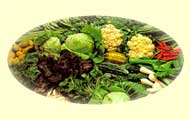| The
Indian KITCHEN/RASOI-GHAR: The kitchen reflects the health
and culture of the people. The Indian kitchen, like its people,
is a happy mixture of the past, present and future. Here,
we want to take you on a journey and bring to you the best
of every age/culture. |
 |
The kitchen is a place which
not only nourishes the people but also it's cultures. We may not
know when exactly the kitchen came into existence. But we can
estimate that it must have come into being only after the discovery
of "FIRE".
Many people have researched into the ARCHITECTURE of kitchens.
You can study it. You can know the various factors considered
by Indians before they chose the location, design, function and
contents of their kitchens.
Our forefathers have made this into a science. VAASTU is the Indian
Science of architecture, which gives rules for planning every
structure. The placement of the kitchen also assumes great importance.
It is from the kitchen that the lady of the house administers
her "Kingdom" (Or Queendom!).
VAASTU is very scientific. For example, it says that the source
of fire (for cooking) should ideally face the east direction.
Since the sun's rays come from the east for a greater part of
the day, so it provides light. Sun's rays are infact now found
to have the quality of destroying several bacteria too. The food,
while being prepared, receives added energy. The cook also, while
cooking receives that extra energy needed to do the cooking with
enthusiasm.
MATA ANNAPOORNESHWARI is revered traditionally as the provider
of food to humanity. Anna means "food" and poorneshwari means
the "Goddess who gives fullness". In south-India, there is a temple
dedicated to Annapoorneshwari. Our forefathers believed that whatever
we eat should be first offered to the source from where it has
come, and then alone should it be eaten.
The traditional Brahmins still continue to do "NAIVEDYAM" and
then eat their food. It is a systematic process of invoking the
"Pancha -Pranas" and then offering it to the body as a temple.
The stomach that has the power to digest food is compared to the
Homa-Kunda (or sacrificial fire) to which we offer food as a matter
of divine's offering to our life. Just as our body is made of
the "Pancha Mahabhootas", so also the food we eat is made of the
five basic elements. A little understanding of this can go a long
way in regulating our food and thereby our health. For example:
Water is available in abundance and is valuable for life. The
human body is composed of 70% water. Water is the only substance,
which actively quenches our thirst. Other beverages will relieve
thirst only in proportion of the water they contain. Most drinks
(apart from fresh fruit juices and herbal drinks) are injurious
because of unwholesome substances added to them. Hence water in
its pure form is the best beverage. Through water, nutrients enter
the blood stream and reach the critical areas of the human body,
which need repair and growth.
Mother's love and her tender fostering care is a very important
part of the welfare and nurturing for the family. The added ingredient
of love which a mother adds to the family meals can only be available
in a home and nowhere else. In earlier times many mothers would
be mentally chanting "japa" prayer, or "mantra" while preparing
the meals and going about their daily chores. This chanting leads
to positive energy in the food she prepares and the divine vibrations
not only nourish the family physically, but mentally, emotionally
and spiritually as well. In keeping with the saying "We are what
we eat", the mother maintains her purity of thoughts while preparing
the meals. It was their love which Shivaji Maharaj received from
his mother since his childhood which moulded him into a physically
and spiritually strong human-being,a jewel among Indian heroes.
Over the centuries a wide variety of food have been evolved in
India. India being a very vast country, different types of food
exist over the various regions. Some people believe that Indian
food is too hot and spicy. This may be partly true in the case
of a few old recipes. But these recipes can be toned down without
loosing out on its flavor, aroma and texture of the food. Many
ingredients and herbs which are added to the Indian cooking actually
aid digestion. Actually, some of these herbs also form the basis
of science of Indian Ayurvedic medicines. The grandmother of the
house (dadima) was supposed to be a walking repertory of homely
remedies and surefire cures for common ailments. In order to have
the best of Indian cooking the housewife requires the right combination
of experience, knowledge of food, some common sense and a bit
of experimentation to try her combinations. The modern Indian
Housewife realizes, that, to give her family a healthy, balanced,
and nutritive diet ,is, of utmost importance.
PANCHA KOSHA Shuddhi : Cleaning our five bodies. Every human being
exists at five levels; or one can say that man has five bodies
or "sheaths"
1) ANNAMAYA Kosha : This is the gross body, including all the
tissues, organs etc. Nourishment to the body in the form of food
and liquids is absorbed directly into this physical level. The
purity and health of this body will determine the health of a
person. By eating Indian health foods, you can increase health,
vigor and vitality.
2) PRANAMAYA Kosha
3)MANOMAYA Kosha
4)VIGNANAMAYA Kosha
5)ANANDMAYA Kosha
By bringing about cleansing in all these levels, You can be healthy
and even GROW YOUNGER This is also known as "KAYA-KALPA."
©
2001Vandemataram.com All rights reserved.
|